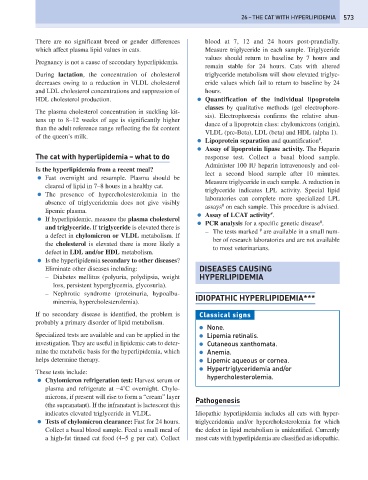Page 581 - Problem-Based Feline Medicine
P. 581
26 – THE CAT WITH HYPERLIPIDEMIA 573
There are no significant breed or gender differences blood at 7, 12 and 24 hours post-prandially.
which affect plasma lipid values in cats. Measure triglyceride in each sample. Triglyceride
values should return to baseline by 7 hours and
Pregnancy is not a cause of secondary hyperlipidemia.
remain stable for 24 hours. Cats with altered
During lactation, the concentration of cholesterol triglyceride metabolism will show elevated triglyc-
decreases owing to a reduction in VLDL cholesterol eride values which fail to return to baseline by 24
and LDL cholesterol concentrations and suppression of hours.
HDL cholesterol production. ● Quantification of the individual lipoprotein
classes by qualitative methods (gel electrophore-
The plasma cholesterol concentration in suckling kit-
sis). Electrophoresis confirms the relative abun-
tens up to 8–12 weeks of age is significantly higher
dance of a lipoprotein class: chylomicrons (origin),
than the adult reference range reflecting the fat content
VLDL (pre-Beta), LDL (beta) and HDL (alpha 1).
of the queen’s milk.
#
● Lipoprotein separation and quantification .
● Assay of lipoprotein lipase activity. The Heparin
The cat with hyperlipidemia – what to do response test. Collect a basal blood sample.
Administer 100 IU heparin intravenously and col-
Is the hyperlipidemia from a recent meal?
lect a second blood sample after 10 minutes.
● Fast overnight and resample. Plasma should be
Measure triglyceride in each sample. A reduction in
cleared of lipid in 7–8 hours in a healthy cat.
triglyceride indicates LPL activity. Special lipid
● The presence of hypercholesterolemia in the
laboratories can complete more specialized LPL
absence of triglyceridemia does not give visibly
#
assays on each sample. This procedure is advised.
lipemic plasma.
#
● Assay of LCAT activity .
● If hyperlipidemic, measure the plasma cholesterol
#
● PCR analysis for a specific genetic disease .
and triglyceride. If triglyceride is elevated there is
#
– The tests marked are available in a small num-
a defect in chylomicron or VLDL metabolism. If
ber of research laboratories and are not available
the cholesterol is elevated there is more likely a
to most veterinarians.
defect in LDL and/or HDL metabolism.
● Is the hyperlipidemia secondary to other diseases?
Eliminate other diseases including: DISEASES CAUSING
– Diabetes mellitus (polyuria, polydipsia, weight HYPERLIPIDEMIA
loss, persistent hyperglycemia, glycosuria).
– Nephrotic syndrome (proteinuria, hypoalbu-
IDIOPATHIC HYPERLIPIDEMIA***
minemia, hypercholesterolemia).
If no secondary disease is identified, the problem is Classical signs
probably a primary disorder of lipid metabolism.
● None.
Specialized tests are available and can be applied in the ● Lipemia retinalis.
investigation. They are useful in lipidemic cats to deter- ● Cutaneous xanthomata.
mine the metabolic basis for the hyperlipidemia, which ● Anemia.
helps determine therapy. ● Lipemic aqueous or cornea.
● Hypertriglyceridemia and/or
These tests include:
hypercholesterolemia.
● Chylomicron refrigeration test: Harvest serum or
plasma and refrigerate at −4˚C overnight. Chylo-
microns, if present will rise to form a “cream” layer
Pathogenesis
(the supranatant). If the infranatant is lactescent this
indicates elevated triglyceride in VLDL. Idiopathic hyperlipidemia includes all cats with hyper-
● Tests of chylomicron clearance: Fast for 24 hours. triglyceridemia and/or hypercholesterolemia for which
Collect a basal blood sample. Feed a small meal of the defect in lipid metabolism is unidentified. Currently
a high-fat tinned cat food (4–5 g per cat). Collect most cats with hyperlipidemia are classified as idiopathic.

